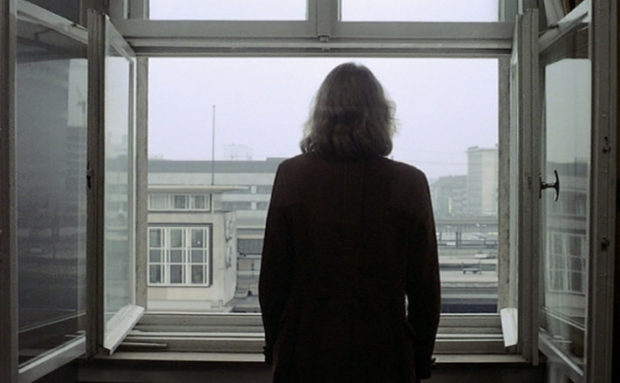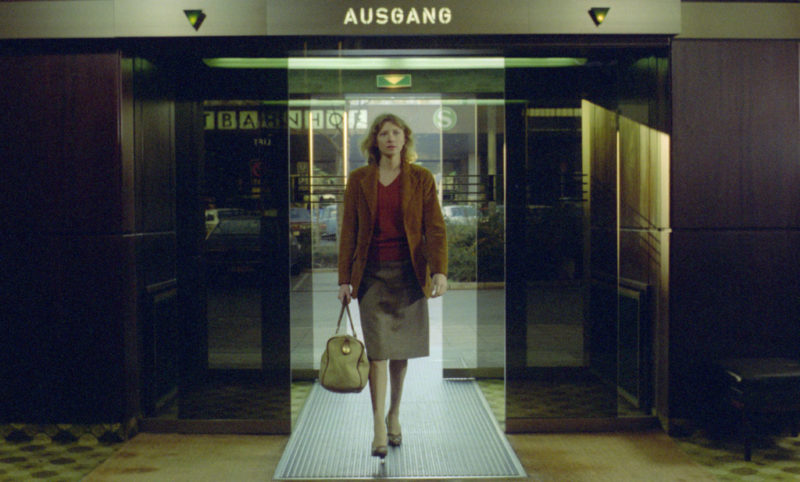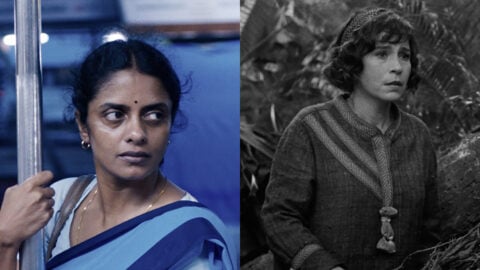Queer & Now & Then: 1978
In this biweekly column, I look back through a century of cinema for traces of queerness, whether in plain sight or under the surface. Read the introductory essay.

Few filmmakers were as formally complete as Chantal Akerman. Perhaps none ever put forth an oeuvre as richly unified in character and technique; the narrative and structuralist conceits of her films were equally informed by her sexuality, ethnicity, and nationality. Though the Belgian filmmaker spoke of her influences—including Michael Snow, Yvonne Rainer, and Jonas Mekas, all of whom she discovered upon her epochal relocation to New York in 1971—not one of her films feels like it’s flaunting avant-garde technique or received ideas of durational cinema. Something from deep inside her came out in the very bones of each of her films. One of the many encouraging results of a contemporary cultural discourse preoccupied with issues around identity is that Akerman’s work has been more widely admired and appreciated by new generations of cinephiles who previously may only have known her via her 1975 masterpiece Jeanne Dielman, 23, Quai du commerce, 1080 Bruxelles. (Tragically this renaissance has come only after her death.) Akerman was Jewish. Akerman was queer. Akerman was Belgian. These were not incidental facts to a body of work about isolation, dislocation, and social marginalization: she was an artist for whom identity was key, although also inchoate and complex and abstract. Akerman made her own persona and inner life central to her work without making her work all about herself.
The structures she imposed on her work produced films that were anything but rigid. Akerman was a lesbian filmmaker who rejected any kind of easy labeling (she was on the record as considering it reductive for her films to show specifically at gay-lesbian film festivals), and her belief in the fluidity of sexuality was evident early in her career. Her first narrative feature, 1974’s Je tu il elle, shot on 16mm in just over seven days, manages to be both grueling and exhilarating in its depiction of a nomadic woman’s self-imposed routine. Played by Akerman herself, the protagonist compulsively writes letters to an unknown recipient, rearranges furniture in a sparsely decorated flat, day after day, hour after hour, in unbroken takes; the film’s second half becomes a sort of road trip movie, in which she hitchhikes back to Brussels, having sexual encounters (if not finding satisfaction or release, necessarily) with both a male truck driver and a female ex-lover. With the latter (Claire Wauthion), Akerman enacts a remarkable, explicit, yet de-eroticized, 10-minute-plus sex scene. She shoots the commingling of the women’s bodies, stretched out before the camera in a sculptural, non-exploitative composition, at a remove, which, coming so early in her career, registers as a kind of statement of purpose.
With the next year’s Jeanne Dielman, radically made with an entirely female crew, Akerman would even more intensely retrain viewers’ eyes, again encouraging our hyperawareness of a woman’s circumscribed routine. As major as Kubrick’s 2001: A Space Odyssey in its own way, Jeanne Dielman is a dramatic rethinking of narrative cinema, and created not a small sensation on the art-film scene. Her next narrative feature, Les Rendez-vous d’Anna, coming on the ever-fickle festival circuit in 1978 with high expectations, was considered at the time a disappointment; but, like any great artist, Akerman was furthering and complicating her own inquiries and aesthetic practices rather than repeating. Hopefully more widely appreciated today, this is a complex, exquisitely composed work on the elusive natures of identity and happiness.
Fixated on staircases, windows, trains, waiting platforms, and hotel rooms, Les Rendez-vous d’Anna is a film of thresholds. Our disconnected main character this time is Anna, played with unsettled restraint by Aurore Clément. We first see her, as we often will, from a distance. In her typically static opening shot, Akerman shows us a mostly empty train station in a German town; eventually a train pulls up to the track on the right, and Anna emerges unceremoniously, the camera not in any hurry to spot her as she moves to a phone booth in the back of the center frame. After making a call we are not privy to hear, she walks in the direction of the camera before descending the staircase that has been lying in wait in the foreground. Already, Anna has been established in purely formal terms, as someone clearly far from home, whose destination is unclear to us, and who is somehow one with her modern surroundings: a place of entrances and exits, cold, transitory.

Environmental estrangement gives way to a more existential sort when she arrives at her hotel, where a reservation has been prearranged in her name. In her brief conversation with the front desk clerk we learn much of the film’s most direct exposition: she is a movie director, in town to present her latest film at a small festival. The clerk immediately addresses her in terms of gender, using the essentializing term directrice when inquiring about her work; he then tells her that she has a message from her mother, which prompts a surprised Anna to wonder, “How did she know I was here?” Swiftly, Akerman sets up two overbearing forces, one social and one familial, inferring internal and external struggles that will recur over the course of the film and, implicitly, throughout the rest of her life: Anna’s need to define herself as an artist and person in a world that constantly reduces her to “woman filmmaker” or “daughter.” Akerman’s film goes on to interrogate traditional ideas of loneliness, as Anna will have a series of encounters, with men and women—some strangers, some family—who try to define that loneliness and prescribe unsolicited remedies for it.
In the film’s first tracking shot, the camera moves left to right with Anna as she opens the curtains in her hotel room; we then remain with her from behind as she opens the window and looks out into the evening. The sound of a train screeching by implies her room is right over the train station, granting it even more of a sense of impermanence. Trying to make a phone call to Italy, she has been told there’s a two-hour wait; we feel time passing as Anna lies in bed, the room adorned with an almost chokingly ornate leaf-patterned wallpaper and an adjoining empty bed emphasizing the room’s solitude.
On this first night, following her screening, Anna meets Heinrich (Helmut Griem), though we don’t see how they first connected. She and the handsome stranger end up together back in his hotel, but after some mechanically intimate moments, she stops herself: “We don’t love each other.” Unable to consummate the one-night stand, she tells him to get dressed. (A queerness is already laid over the proceedings thanks to the casting of German actor Griem, recognizable from his work in Visconti’s The Damned and Ludwig and Bob Fosse’s Cabaret, in which he famously played Maximilian, the outrageously wealthy boy-toy of both Liza Minnelli and Michael York.) Though Anna and Heinrich do not have sex, he invites her to visit his home the next day in nearby Bottrop to meet his five-year-old daughter. She agrees, and outside his house, against a bleak, slate-gray sky, the grade-school teacher opens up to an almost absurd extent, telling her of his solitude following his divorce but also, in a delicately arch manner, relaying unbidden the economic and social realities of contemporary Germany. He offers a primer on his country’s baleful 20th-century history as a kind of contextualization for his own woes: his father died in Stalingrad; his wife left him for a Turk. He seems to equate the notion of rebuilding Germany from its post-WWII destruction with the reconstruction of his own personal, familial ruins. Anna listens with a placidity that might register as either boredom or sympathy, and kindly enters his home to meet his daughter and mother—as per usual, Akerman leaves her camera outside, making the meeting, and the visual details of his domesticity, an abstraction. His evident desperation for contact is not mirrored by Anna’s behavior; following lunch, she politely leaves, walking away across endless fields as he looks after her, stoically.
Since we’re given no interior monologue, Anna is left opaque; we project on to her as other characters do. Her next encounter, in Cologne, with a middle-aged longtime acquaintance, elucidates more of her past but further frustrates any conventional reading of her. Ida (Magali Noël), whose son is a former fiancé of Anna’s, offers bromides (“Don’t dwell on the past…”) and imposes psychological readings (“Maybe you don’t like children…”) that lead to emotional dead ends. She positions her own romantic experiences as somehow models for behavior, talking about the intense love at first sight she felt for her husband, while countering it with the sad reality that their relationship has turned bitter and resentful. Going against her own advice, she dwells on the past: “How sweet he was, how proud I felt.” She wishes that Anna would have married her son, whom she calls “a very sensitive boy.” It sounds as though she’s suggesting a marriage of convenience as a means of staving off “terrible” loneliness. But which of these two women is the truly lonely one? As the scene ends on a train platform, as such scenes so often do, it’s Anna who is trying to cheer up Ida: “Don’t worry, everything will be fine.”
Anna embarks on a long ride back to her hometown of Brussels; recuperating from her encounter with Ida, she’s filmed in a moody long take in her dark train compartment, pensive as she drags off her cigarette. After an off-screen voice chastises “No smoking,” she rises and squeezes herself through the tightly packed train to find a quieter spot, stopping beside an attractive male stranger (Hans Zischler). They look out the windows together, frozen in time as the countryside rushes by. This liminal sequence provides her breathing room and functions as a kind of narrative interlude before the film’s emotional centerpiece: Anna’s meeting with her mother.
She is waiting for Anna at the station when the train pulls in. Akerman shoots them distant in the frame as they embrace, and in the next scene keeps them in long shot as they take a seat together in the back of a restaurant. Finally, we move in closer, and the two speak of the family business (hit by the recession) and aging (she tells Anna she looks like her mother). After this, the women’s intimacy grows increasingly pronounced. Like lovers, Anna and her mother get a hotel room. The daughter undresses in front of the mother, who betrays a maternal longing (“Let me look at you”). As the two lie side by side in bed, seen in a direct overhead shot, Anna embarks on a monologue about her first lesbian experience, which deepens and complicates their bond. “We kissed. I don’t know how it happened . . . I felt nauseated . . . But we kept on kissing. Then it all became very easy.” The familial and the sexual commingle, as Anna tells her, “For some strange reason I thought of you.” The scent of her mother’s perfume, the memory of the encounter, waft across the scene, creating a comfortable, erotic tension that concludes with the women in embrace.
Anna in her mother’s arms is a powerful and lucid image for a film that’s partly about a woman questioning her relationship to the idea of motherhood. Akerman’s close bond with her mother, Natalia, a Holocaust survivor, was a prime motivating force in her daughter’s filmography, from Jeanne Dielman to 1976’s nonfiction masterpiece News from Home—whose soundtrack is entirely constructed of Akerman reading letters her mother wrote to her while she was in New York—to her effortlessly beautiful final film from 2016, No Home Movie, shot on video in her mother’s apartment during her (and, as it would turn out, Akerman’s) final years. Both films are products of a Jewish diasporic cinema, as is, more subtly, Les Rendez-vous d’Anna, with its portrait of extreme dislocation.

Anna’s final encounter, in Paris, with ex-lover Daniel (Jean-Pierre Cassel), feels like a crucial coda. Following a nighttime sojourn through the city streets, the two end up in another austere, modern and indistinguishable hotel-like apartment. A television fuzzes and flickers in the left of the frame as the two stare out the sliding glass balcony door in a composition that recalls the beginning of the film, when Anne looked out the window of her German hotel room: though there are now two of them—and though Daniel is groping Anne’s rear over her skirt—she doesn’t seem any less alone. Soon they are in bed; she lies on top of him naked, while he, increasingly feverish from a cold, remains clothed. Gone is the intensely physical rutting of the two women in the similarly static horizontal frame of Je tu il elle. Either out of concern, or more likely needing time and space to herself, she leaves to fetch him cold medicine. Upon returning, she finds Daniel face down in bed; he’s naked, though this time she remains clothed (never the twain shall meet). She proceeds to rub topical ointment on his back in a gesture that skirts the line, naturally, between the maternal and the erotic. When she gently places a hand in the vicinity of his ass, he demurs, necessitating the end of another thwarted sexual encounter.
Soon she returns home and listens to her answering machine’s many messages, alternating between business and personal matters, echoing in her empty bedroom. As she lies in bed, her face betrays no particular emotion. “Anna, where are you?” asks an unidentified female voice—friend or lover? Anna’s ennui feels not like an expression of modernity à la Antonioni but rather a result of intentional disassociation. Les Rendez-vous d’Anna registers today as a kind of precursor to the urban films of Tsai Ming-liang, specifically What Time Is It There? in its portrayal of global disconnection and the frustrated pursuit of sexual and spiritual nourishment. Akerman’s cinema, both in her fiction and documentary work, would continue to be one of refugees and expatriates. That satisfaction seems to elude Anna is not framed as a tragedy, however; throughout the film others may offer prescriptions for her (marriage, sex, companionship), yet Akerman seems unconvinced that she needs remedy. We are not meant to pity Anna; she’s an artist, queer, itinerant, and self-possessed, and let’s just say she’s leaving her options open.
A new 2K restoration of Les Rendez-vous d’Anna from Janus Films opens November 16 at BAMCinematek.
Michael Koresky is the Director of Editorial and Creative Strategy at Film Society of Lincoln Center; the co-founder and co-editor of Reverse Shot; a frequent contributor to the Criterion Collection; and the author of the book Terence Davies, published by University of Illinois Press.







